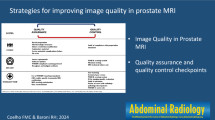Abstract
Purpose
Contrast-enhanced ultrasound (CEUS) is the application of ultrasound contrast agents (UCAs) to traditional medical sonography. The development of UCAs allowed to overcome some of the limitations of conventional B-mode and Doppler ultrasound techniques and enabled the display of the parenchymal microvasculature. Purpose of this paper is to delineate the elements of a solid and science-based technique in the execution of urinary bladder CEUS.
Methods
We describe the technical execution of urinary bladder CEUS and the use of perfusion softwares to perform contrast enhancement quantitative analysis with generation of time–intensity curves from regions of interest.
Results
During CEUS, normal bladder wall shows a wash-in time of 13 s, a time to peak (TTP) >40 s, a signal intensity (SI) <45 % and a wash-out time >80 s; Low-grade urothelial cell carcinoma (UCC) shows a wash-in time of 13 s, a time to peak TTP >28 s, a SI <45 % and a wash-out time of 40 s; High-grade UCC shows a wash-in time of 13 s, a TTP >28 s, a SI >50 % and a wash-out time of 58 s.
Conclusions
CEUS is a useful tool for an accurate characterization of bladder UCC although it has some drawbacks. To avoid misunderstandings, a widely accepted classification and a standardized terminology about the most significant parameters of this application should be adopted in the immediate future.
Riassunto
Obiettivi
l'ecografia con mezzo di contrasto (CEUS) è l'ecografia medica tradizionale con l'utilizzo di mezzi di contrasto ecografici (MDCe). Lo sviluppo di MDCe ha consentito di superare alcune delle limitazioni dell'ecografia B-mode e Doppler convenzionali ed ha consentito la visualizzazione del microcircolo parenchimale. Scopo di questo lavoro è quello di delineare gli elementi di una tecnica solida e basata sull'evidenza scientifica per l'esecuzione della CEUS della vescica urinaria.
Materiali e Metodi
Descriviamo l'esecuzione tecnica della CEUS della vescica urinaria e l'utilizzo di software di perfusione per l’esecuzione dell'analisi quantitativa dell’enhancement contrastografico con la generazione di curve intensità tempo (TIC) delle regioni di interesse (ROI).
Risultati
Durante la CEUS, la parete della vescica normale mostra un tempo di wash-in di 13 sec., un tempo di picco (TTP) >40sec., una intensità di segnale (SI) <45% e un tempo di wash-out >80 sec.; il carcinoma uroteliale (CU) di basso grado mostra un tempo di wash-in di 13 sec., un tempo di picco (TTP) >28sec., un’intensità di segnale (SI) <45% e un tempo wash-out di 40 sec.; il CU di alto grado mostra un tempo di wash-in di 13 sec., un tempo di picco (TTP) >28sec., un’intensità di segnale (SI) >50% e un tempo di wash-out di 58 sec.
Conclusioni
La CEUS è uno strumento utile per una caratterizzazione accurata del CU della vescica anche se possiede alcuni svantaggi. Al fine di evitare incomprensioni, dovrebbero essere adottate in futuro, una classificazione largamente accettata e una terminologia standardizzata sui parametri più significativi di questa applicazione.



Similar content being viewed by others
References
Averkiou M, Powers J, Skyba D, Bruce M, Jensen S (2003) Ultrasound contrast imaging research. Ultrasound Q 19(1):27–37
Claudon M, Dietrich CF, Choi BI et al (2013) Guidelines and good clinical practice recommendations for contrast enhanced ultrasound (CEUS) in the liver—update 2012: a WFUMB-EFSUMB initiative in cooperation with representatives of AFSUMB, AIUM, ASUM, FLAUS and ICUS. Ultrasound Med Biol 39(2):187–210. doi:10.1016
Piscaglia F, Nolsøe C, Dietrich CF (2012) The EFSUMB Guidelines and Recommendations on the Clinical Practice of Contrast Enhanced Ultrasound (CEUS): update 2011 on non-hepatic applications. Ultraschall Med 33(1):33–59. doi:10.1055/s-0031-1281676
Drudi FM, Cantisani V, Liberatore M et al (2010) Role of low-mechanical index CEUS in the differentiation between low and high grade bladder carcinoma: a pilot study. Ultraschall Med 31:589–595. doi:10.1055/s-0029-1245397
Nicolau C, Bunesch L, Sebastia C et al (2010) Diagnosis of bladder cancer: contrast-enhanced ultraound. Abdom Imaging 35:494–503. doi:10.1007/s00261-009-9540-9
Nicolau C, Bunesch L, Peri L, Salvador R, Corral JM, Mallofre C, Sebastia C (2011) Accuracy of contrast-enhanced ultrasound in the detection of bladder cancer. Br J Radiol 84(1008):1091–1099. doi:10.1259/bjr/43400531
Caruso G, Salvaggio G, Campisi A et al (2010) Bladder tumor staging: comparison of contrast-enhanced and gray-scale ultrasound. Am J Roentgenol 194:151–156. doi:10.2214/AJR.09.2741
Li QY, Tang J, He EH, Li YM, Zhou Y, Zhang X, Chen G (2012) Clinical utility of three-dimensional contrast-enhanced ultrasound in the differentiation between noninvasive and invasive neoplasms of urinary bladder. Eur J Radiol 81(11):2936–2942. doi:10.1016/j.ejrad.2011.12.024
Wang XH, Wang YJ, Lei CG (2011) Evaluating the perfusion of occupying lesions of kidney and bladder with contrast-enhanced ultrasound. Clin Imaging 35(6):447–451. doi:10.1016/j.clinimag.2010.11.001
Sistema Nazionale per le Linee Guida ISS (2011) Impiego della diagnostica per immagini delle lesioni focali epatiche
SonoVue, INN-sulphur hexafluoride—European Medicines Agency
Drudi FM, Di Leo N, Malpassini F, Antonini F, Corongiu E, Iori F (2012) CEUS in the differentiation between low and high-grade bladder carcinoma. J Ultrasound 15(4):247–251. doi:10.1016/j.jus.2012.09.002
Li Q, Tang J (2012) Comment on role of low-mechanical index CEUS in the differentiation between low and high grade bladder carcinoma: a pilot study. Ultraschall Med 33(1):87–89. doi:10.1055/s-0031-1281690
Conflict of interest
F. M. Drudi, N. Di Leo, F. Maghella, F. Malpassini, J. Iera, A. Rubini, N. Orsogna and F. D’Ambrosio declare that they have no conflict of interest.
Informed consent
All procedures followed were in accordance with the ethical standards of the responsible committee on human experimentation (institutional and national) and with the Helsinki Declaration of 1975, as revised in 2000 (5). All subjects provided written informed consent to enrolment in the study and to the inclusion in this article of information that could potentially lead to their identification.
Human and animal studies
The study was conducted in accordance with all institutional and national guidelines for the care and use of laboratory animals.
Author information
Authors and Affiliations
Corresponding author
Rights and permissions
About this article
Cite this article
Drudi, F.M., Di Leo, N., Maghella, F. et al. CEUS in the study of bladder, method, administration and evaluation, a technical note. J Ultrasound 17, 57–63 (2014). https://doi.org/10.1007/s40477-013-0032-y
Received:
Accepted:
Published:
Issue Date:
DOI: https://doi.org/10.1007/s40477-013-0032-y




